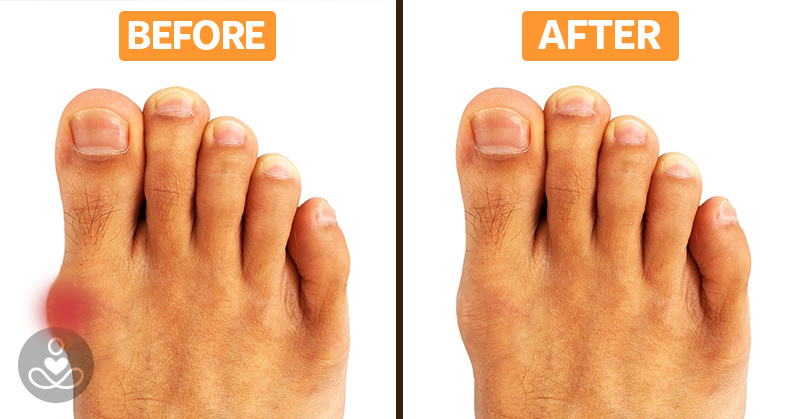Bunions may seem harmless, but they can lead to some pretty serious complications like intense pain, further deformity, and even inflammation in the form of bursitis. Bunions can happen to anyone, and spotting and treating them early can save you from a lot of pain later on in life.
What Exactly Is a Bunion?
For those who are unsure of how to recognize a bunion, it is a bump on the side of the big toe. The bump is a result of an abnormality of the foot bone which causes your big toe to lean inwards instead of straight[1]. This causes the base of the big toe to jut out, which is the bump that you see.
Many people remain unconcerned with their bunions if there is little or no pain involved. However, over time your toes can crowd together which will cause further pain and possibly permanent deformity.
What Causes Bunions?
Bunions are caused by faulty foot structure, which is typically genetic. They can also be caused by stress on your foot or a medical condition such as arthritis[2]. Wearing tight, narrow shoes can often make the bunion worse, and create more pain for the individual.
In the beginning, a bunion may not be painful, but they can become worse over time. There are a number of things that can put stress on the bunion and make it worse:
- Tight or too-small shoes that crowd the toes
- Shoes that have high heels or pointy toes
- Standing for long periods of time
- Arthritis symptoms in your feet
How to Identify a Bunion
Apart from an obvious bump on your foot, there are several common symptoms that can help to identify the presence of a bunion.
- Red and inflamed skin on the side of your big toe
- Big toe turning towards the other toes
- Thick skin on the underside of your big toe
- Calluses on your second toe
- Foot pain that may be persistent, or come and go
- Difficulty moving your big toe
Many people choose not to seek treatment for their bunions, letting the pain worsen over time. There are several options for treatment, both surgical and non-surgical that can help to lessen the pain or remove the problem altogether.
Bunion Treatment Options
1. Surgery
Procedures for bunion removal can be different for each individual, but they often include a bunionectomy. This involves correcting the position of the toe by removing some of the bone and removing swollen tissue around the affected joint[1].
Your doctor will only recommend a bunion surgery when other less invasive treatments have failed and if your pain is so acute that you are unable to carry out everyday tasks. There are over 100 different methods used for bunion surgery; it can be a complex procedure and so is used as a final option.
Full recovery from a bunionectomy can take up to 8 weeks to heal, but often times patients are able to walk around immediately following the procedure[1].
2. Home Remedies & Prevention
All bunions are permanent without surgery. But, that doesn’t mean that you need to live with foot pain if you’re opting out of surgery. Podiatrist Dina Stock recommends a number of at-home solutions that will help to ease pain caused by bunions and to help slow a bunions progression.
“For many people, it may simply be a matter of wearing properly fitting shoes,” Dr. Stock says. “Be sure to choose low-heeled, comfortable shoes that provide plenty of space for your toes and the widest part of your foot”[3].
Wear Shoes That Fit
Choose your shoes carefully. Wear well-fitting footwear that is wide in the toe area and conform to the shape of your foot without causing pressure or pinching. Avoid high-heeled shoes or shoes that are pointy.
Shoe Inserts
You can protect your bunion by inserting moleskin or gel-filled pads into your shoes. Inserts can also help to position the foot properly. These can be over-the-counter arch supports or prescription orthopedic devices.
At-Home Bunion Treatment
Set up a routine of warm soaks, ice packs, and massage to help alleviate pain and tension in your feet. Applying ice packs can help alleviate pain and inflammation; follow up with warm soaks to help to relax the muscles in your foot and relieve tension. Try this simple massage routine afterwards:
One study suggests that 23% of adults aged 18-65 years suffer from bunions. That number increases to 35.7% in elderly people aged over 65 years[4]. You don’t need to live in pain from your bunions. By learning how to identify and treat them you can greatly decrease the amount of pain caused by bunions. So go ahead, wear your sandals with pride, bunions or not.
3. Maintain a normal weight
Extra weight tends to put more tension on the feet. Eating a healthy diet and creating a good exercise routine will help to ensure that there is no added tension on your feet.
4. Exercises
Exercises that target specific areas of the foot can do wonders for strengthening tissue around the bunion. This video outlines appropriate ways to incorporate muscle-building exercise into your day that will help to strengthen your foot:
Sources
- [1] Healthline Editorial Team. Bunions. Retrieved from https://www.healthline.com/health/bunions#overview1
- [2] Mayo Clinic Staff. (2017, July 29). Bunions. Retrieved from https://www.mayoclinic.org/diseases-conditions/bunions/symptoms-causes/syc-20354799
- [3] Cleveland Clinic Staff. (2014, December 12). 7 Ways to Ease Your Bunions Without Surgery. Retrieved from https://health.clevelandclinic.org/2014/12/7-ways-to-ease-your-bunions-without-surgery/
- [4] Sheree Nix, Michelle Smith, Bill Vicenzino. (2010, September 27). Prevalence of Hallux Valgus in the General Population: A Systematic Review and Meta-Analysis. Retrieved from https://www.ncbi.nlm.nih.gov/pmc/articles/PMC2955707/

